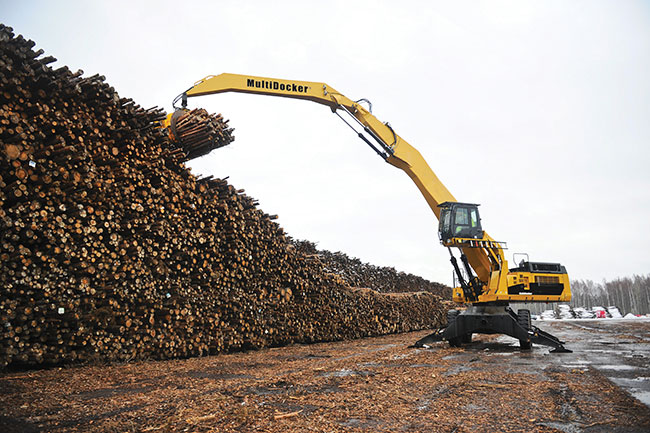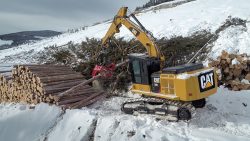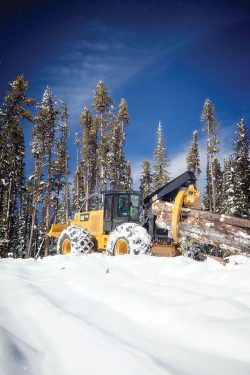
Features
A First Nations approach to success
How partnerships enhance success and sustainability
December 19, 2022 By Harold Reimer
 Equipment and technology dealers can offer support through purchase and lease arrangements.
Photos courtesy of Finning.
Equipment and technology dealers can offer support through purchase and lease arrangements.
Photos courtesy of Finning. A vibrant and sustainable forestry sector and associated revenues are critical to British Columbia’s economy, generating over $13 billion in GDP annually. For a sector that employs more than 43,000 people and makes up 29 per cent of B.C.’s total commodity export value, long-term sustainability is not just important, but crucial to the livelihoods of so many. The forestry sector depends on the right balance of economic and environmental longevity. As the province starts to move away from traditional governance to one of reconciliation, B.C. First Nations will play a key role in the industry’s future.
Recent changes to government legislation and policies in the forestry sector will increase tenure for First Nations communities, allowing greater opportunity to experience economic benefits that come from resources being harvested on traditional and territorial Indigenous land. There are . new opportunities to create mutually beneficial partnerships, from government and private companies to equipment and technology dealers. The path to success depends on working together to support communities and businesses through respectful and collaborative partnerships. The relationship should place trust at the forefront, then provide the right financing, training, tools and support to help businesses get started on their journey to economic prosperity.
A new model for a better future
All lands in B.C. fall within the traditional or territorial boundaries of one or more First Nations. According to B.C.’s Ministry of Forests, Lands and Natural Resource Operations, of the approximately 48 million cubic metres of harvestable timber within Crown forest tenure systems, First Nations and communities, about 27 million is held by five companies, creating challenges for others to expand or acquire guaranteed long-term forest management tenure needed to warrant investment in equipment.
Potential legislation will allow the B.C. government to take some tenure back and redistribute it to First Nations and smaller companies. This is partly the result of the Declaration on the Rights of Indigenous Peoples Act, passed into law in November 2019. It states that forests must be managed in a way that protects and enhances Indigenous people’s ability to exercise their rights and uphold cultural values. It also promises to significantly improve forestry revenue-sharing.
As more commercial forests come under First Nation management, it’s set to double previous dividends, which could see more than $130 million distributed this fiscal year to 184 eligible Nations. These communities will now be able to generate their own source of income and become independent, self-governing nations – should they choose to explore that option. For the industry as a whole, the benefits are clear – new jobs, new business opportunities and a chance to ensure a brighter future with greater prosperity for the forestry sector.
Supporting Indigenous economic reconciliation through partnerships
Collaborative initiatives and partnerships between First Nations and industry are already creating new jobs and opportunities, but more can be done. Building relationships through reconciliation, rather than governance, is key. Companies can support new business connections, skills training, and offer education close to home so Indigenous peoples can invest both money and skills back into the community. Supporting new business ventures can provide more ownership opportunities in forest infrastructure, sawmills, procurement, waste removal, and biomass companies to name a few. However, considerations need to be made around the owning and operating costs of new equipment, not to mention the learning curves for operators. Identifying and addressing the skills gap and offering training is equally as important as providing capital. And new technologies are unlikely to be used if they’re not cost-effective or don’t function well in harsh environments and remote forests.
 Equipment and technology dealers can offer support through purchase and lease arrangements – structuring deals to ensure a better process is followed and crucial after sales support is provided. New technology can be brought into communities to map topography, track emissions and monitor fuel burn – helping to preserve waterways, biodiversity and effective planning for seven generation legacy which is very important to Indigenous communities across Canada.
Equipment and technology dealers can offer support through purchase and lease arrangements – structuring deals to ensure a better process is followed and crucial after sales support is provided. New technology can be brought into communities to map topography, track emissions and monitor fuel burn – helping to preserve waterways, biodiversity and effective planning for seven generation legacy which is very important to Indigenous communities across Canada.
As more companies start to focus on sustainability and transparency in how they operate, they are also placing value on becoming better stewards of the land and communities in which they operate. ESG targets are becoming bolder and more ambitious. For the industry, Indigenous partnerships can offer an invaluable perspective. Generational knowledge such as forest cycles, pest and disease control, land use, and natural resources have been passed down for generations. A deeper understanding of the land can not only help create a better future for the industry but help grow it. And for many, this isn’t just the right thing to do, it will soon be required for a continued licence to operate.
When done correctly, partnerships are a win-win for both sides. They can also create local opportunities for employment, ensuring people can remain in their communities, rather than having to seek work away from home. But it requires a careful, transparent approach to ensure values are represented in the relationship. Addressing all the economic, social, cultural, and environmental challenges of managing forest lands and resources is a complex task and Indigenous relations will play a key role.
Here are some steps the forestry sector can take to help support the communities in which they operate.
Create trust first, listen respectfully and foster an open dialogue
One of the most important components of a successful partnership is a positive relationship between everyone involved. Recognize that it takes time and energy to build trust with a community. And despite the potential for economic prosperity, patience and respect are paramount for communities that are cautious when it relates to resource development. Effective understanding, listening, communication and information sharing from both sides will help ensure future success. Don’t just consider business values and needs, but the cultural and political complexities of the whole community. Find out what the goals of the community are, such as increased training for youth or capacity development for the existing workforce and then jointly formulate a plan as to how you can support those.
Set long-term goals and objectives with assurance they will not be left behind
Forests take decades to become established, so a long-term multi-generational view is an inherent nature of the forestry sector. A natural balance of near-term and long-term considerations can give collaborations a higher probability for success. Leaders do not just focus on today or next year – their decisions are based on the impact their decisions will have on future generations. Seventh-generation decision-making is an important part of Indigenous culture-making choices based on how it will affect their community for decades, if not hundreds of years, into the future. For many companies, this may involve a shift in thinking. With this in mind, patience is key. Start with manageable levels of commitment and remembering relationships, not corporate policy, can determine the success or failure of the partnership.
Be ready to outline exactly what your support includes
 B.C. First Nations have been working seasonal logging jobs for many years. There are also many Indigenous-owned smaller scale logging and sawmill operations. With education amongst these communities improving, there is a greater opportunity for more. Working committees and board memberships that include both industry and community can help ensure short and long-term agreements are properly implemented. Helping to develop better business acumen through mentorships – understanding budgets and planning, business strategy, forecasting and reporting, can provide the knowledge needed for long-term success.
B.C. First Nations have been working seasonal logging jobs for many years. There are also many Indigenous-owned smaller scale logging and sawmill operations. With education amongst these communities improving, there is a greater opportunity for more. Working committees and board memberships that include both industry and community can help ensure short and long-term agreements are properly implemented. Helping to develop better business acumen through mentorships – understanding budgets and planning, business strategy, forecasting and reporting, can provide the knowledge needed for long-term success.
Assistance with government incentives that promote Indigenous-owned operations is also key – they can apply for additional funding and grants from the government which in turn, can help raise additional capital needed to grow their business.
First Nations at the heart of the forestry industry
The last five years have seen rapid deployment of government, industry and Indigenous economic reconciliation. According to a recent report from Export Development Canada there are now more than 50,000 Indigenous-owned businesses in Canada, contributing an estimated $30 billion to the national economy each year. Indigenous youth are predicted to help support the upcoming labour gap, reaching a population of 1 million by 2027, growing at four times the national average. And with most of their homes located in remote, resource-rich areas, the right business opportunities mean they have the chance to develop new skills and knowledge, which will contribute to the prosperity and future of the communities where they live.
First Nations People inherently have a deep-rooted connection to the land. They also own businesses, employ community members, and have meaningful partnerships. There is increased pressure among everyone in the industry to secure a stable industry for future generations. Ensuring financial and environmental longevity does not come until we recognize First Nations as playing a pivotal role in this. They are ready to grow the economy and are active contributors towards Canada’s GDP, but for long-term success, those entering the industry will need our support and collaboration. So, if you’re operating in the forestry sector today, you should consider providing an increased level of operational knowledge, training and business expertise to those within B.C.’s First Nations communities who are willing to participate.
Harold Reimer is the Indigenous business development manager at Finning Canada.
Print this page